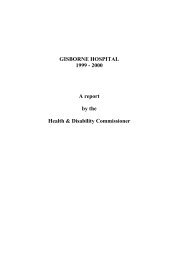09HDC01565 - Health and Disability Commissioner
09HDC01565 - Health and Disability Commissioner
09HDC01565 - Health and Disability Commissioner
Create successful ePaper yourself
Turn your PDF publications into a flip-book with our unique Google optimized e-Paper software.
<strong>Health</strong> <strong>and</strong> <strong>Disability</strong> <strong>Commissioner</strong><br />
Information <strong>and</strong> consent — proposed treatment — No breach<br />
207. Under Right 6(1)(b) of the Code, Mr A was entitled to the information that a<br />
reasonable patient in his position would expect to receive, including an explanation of<br />
the options available, an assessment of the expected risks, side effects, benefits <strong>and</strong><br />
costs of each option. 40 Under Right 7(1), services should have been provided to Mr A<br />
only if he had made an informed choice <strong>and</strong> given informed consent. 41<br />
208. Overall responsibility for ensuring Mr A was provided with sufficient information<br />
about the proposed treatment <strong>and</strong> obtaining informed consent lay with Dr E. As stated<br />
in a leading text: ―Ordinarily each member of the team of doctors will be deemed to<br />
have separately undertaken the care of the patient when so assigned by the responsible<br />
consultant. However, the consultant as leader of the team remains responsible<br />
throughout…‖. 42<br />
209. When Dr E diagnosed Mr A with a Chiari malformation in 2008, he concluded that<br />
this would best be managed by surgery. Dr E states he did not go through the consent<br />
process at this point, but he noted in his letter to Dr D that he had outlined the risks<br />
<strong>and</strong> benefits of the procedure to Mr A.<br />
210. On the day before surgery, Dr F initiated the written consent process. It was clear at<br />
the end of Dr F‘s discussion with Mr A, that Mr A had reservations about the surgery.<br />
Dr F did not ask Mr A to sign the consent form at that point, but suggested a further<br />
discussion after Mr A had had the opportunity to consider the information Dr F had<br />
provided.<br />
211. When Dr E was informed of the situation, he went to speak with Mr A himself. Dr F<br />
<strong>and</strong> Dr G were also present, but Mrs C was not.<br />
212. Dr E made it clear to Mr A that he did not have to have the surgery, noting that now<br />
that he had a desk job he was relatively asymptomatic, it would therefore be<br />
reasonable to have a period of ―expectant observation‖. Dr E <strong>and</strong> Dr F both recall that<br />
Mr A‘s initial decision was to not proceed with the surgery, but that he then changed<br />
his mind. Dr E states that he reiterated that Mr A would be no better than he was then<br />
(clinically asymptomatic) <strong>and</strong> that the only benefit would be his likely return to<br />
physical exercise. Dr E was satisfied with the explanation of risks that Dr F had given<br />
to Mr A earlier (as documented by Dr F).<br />
213. It is not possible to determine whether, following his initial discussion with Dr E four<br />
months earlier, Mr A had understood that the proposed surgery was not minor.<br />
However, it is evident that he did underst<strong>and</strong> this following his initial discussion with<br />
Dr F. Mr A clearly had concerns, <strong>and</strong> was particularly anxious about the possibility of<br />
40 Right 6(1) — Every consumer has the right to the information that a reasonable consumer, in that<br />
consumer‘s circumstances, would expect to receive, including [...] (b) an explanation of the options<br />
available, including an assessment of the expected risks, side effects, benefits, <strong>and</strong> costs of each option.<br />
41 Right 7(1) — Services may be provided to a consumer only if that consumer makes an informed<br />
choice <strong>and</strong> gives informed consent, except where any enactment, or the common law, or any other<br />
provision in this Code provides otherwise.<br />
42 Kennedy, I. <strong>and</strong> Grubb, A. Medical Law (London: Butterworths, 2000), p 281.<br />
5 September 2012 36<br />
Names have been removed (except Canterbury DHB <strong>and</strong> the experts who advised on this case) to<br />
protect privacy. Identifying letters are assigned in alphabetical order <strong>and</strong> bear no relationship to the<br />
person’s actual name.
















